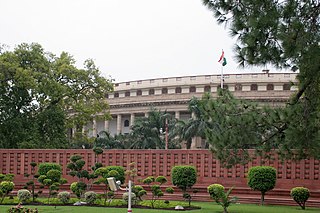Related Research Articles

The Indian Institute of Science (IISc) is a public, deemed, research university for higher education and research in science, engineering, design, and management. It is located in the southern Indian city of Bangalore, Karnataka. The institute was established in 1909 with active support from Jamsetji Tata and thus is also locally known as the Tata Institute. It was granted a deemed university status in 1958 and recognized as an Institute of Eminence in 2018.

The National Security Guard (NSG), commonly known as Black Cats, is a counter-terrorism unit of India under the Ministry of Home Affairs. It was founded on 16 October 1984, following Operation Blue Star, to combat terrorist activities and protect states against internal disturbances. Formalised in the Parliament of India under the National Security Guard Act, 1986. It is one of the seven Central Armed Police Forces of India.

Terrorism in India, according to the Home Ministry, poses a significant threat to the people of India. Compared to other countries, India faces a wide range of terror groups. Terrorism found in India includes Islamic terrorism, ultranationalist terrorism, and left-wing terrorism. India is one of the countries most impacted by terrorism.
Munish Chander Puri was Professor Emeritus of Mathematics at IIT Delhi. He was Organizing Chair, Asia Pacific Operational Research Societies (APORS). He was killed in Bangalore in the 2005 Indian Institute of Science shooting.

The 2001 Indian Parliament attack was a terrorist attack on the Parliament of India in New Delhi, India on 13 December 2001. The attack was carried out by five armed assailants that resulted in the deaths of six Delhi Police personnel, two Parliament Security Service personnel, and a gardener. All the five terrorists were killed by security forces.
Events in the year 2008 in the Republic of India.
2008 Bangalore serial blasts occurred on 25 July 2008 in Bangalore, India. A series of nine bombs exploded in which 1 person was killed and 20 injured. According to the Bangalore City Police, the blasts were caused by low-intensity crude bombs triggered by timers.
The 2008 Ahmedabad bombings were a series of 21 bomb blasts that hit Ahmedabad, India, on 26 July 2008, within a span of 70 minutes. Fifty-six people were killed and over 200 people were injured. Ahmedabad is the cultural and commercial heart of Gujarat state and a large part of western India. The blasts were considered to be of low intensity and were similar to the Bangalore blasts, Karnataka which occurred the day before. This bombings were done by Pakistani Islamic Terrorist group Harkat-ul-Jihad al-Islami.
The 13 September 2008 Delhi bombings were a series of five synchronised bomb blasts that took place within the span of a few minutes on Saturday, 13 September 2008 at various locations in Delhi, India. The first bomb exploded at 18:07 IST, and four other blasts followed in succession, with at least 20 people killed and over 90 injured.

The 2008 Mumbai attacks were a series of terrorist attacks that took place in November 2008, when 10 members of Lashkar-e-Taiba, a militant Islamist organisation from Pakistan, carried out 12 coordinated shooting and bombing attacks lasting four days across Mumbai. The attacks, which drew widespread global condemnation, began on Wednesday 26 November and lasted until Saturday 29 November 2008. A total of 175 people died, including nine of the attackers, with more than 300 injured.

Maj. Sandeep Unnikrishnan, AC was an Indian Army officer, who was serving in the 51 Special Action Group of the National Security Guard on deputation. He was killed during the November 2008 Mumbai attacks and was posthumously awarded the Ashoka Chakra, India's highest peacetime gallantry award, on 26 January 2009.
Rukhsana Kausar KC is a Gujjar woman from Upper Kalsi known for the 2009 shooting of a LeT terrorist at her home, in Rajouri district of Jammu and Kashmir (J&K), India. She was born to Noor Hussain and Rashida Begum. A Class 10 dropout, she has been awarded the India National Bravery Award, for the killing of a Laskar-E-Taiba terror cell leader, Abu Osama, at her residence, using an axe and AK47 rifle. She has a younger brother, Aijaz, who helped her chase the other terrorists involved in the home invasion and contact the police afterward.
The 2010 Jama Masjid attack occurred on 19 September 2010 when two gunmen on a motorcycle fired at a tourist bus near Gate 3 of the Jama Masjid in Old Delhi, India and injured two Taiwanese tourists. The incident provoked fears about security for the upcoming Commonwealth Games in Delhi. About three hours later a car parked approximately 150 meters from the spot caught fire, apparently due to a minor blast.
From late 2011 to 2014, Kenya experienced an upsurge in violent terrorist attacks. Kenyan government officials asserted that many of the murders and blasts were carried out by al-Shabaab in retaliation for Operation Linda Nchi, a coordinated military mission between the Somalian military and Kenyan military that began in October 2011, when troops from Kenya crossed the border into the conflict zones of southern Somalia. According to Kenyan security experts, the bulk of the attacks were increasingly carried out by radicalized Kenyan youth who were hired for the purpose. Kenya security officials also indicated that they were part of death squads, which carried out many of the killings under the orders of a government security council. By mid-2014, the cumulative attacks began affecting Kenya's tourism industry, as Western nations issued travel warnings to their citizens.
A bomb explosion known as the 2013 Bangalore bombing occurred on 17 April 2013 in Bangalore, India, at 10:30 (IST) near the Bharatiya Janata Party Karnataka New State Office Jagannath Bhawan, on Temple Street 11th Cross, Malleswaram.
On 27 July 2015, three gunmen dressed in army uniforms opened fire on a bus and then attacked the Dina Nagar police station in Gurdaspur district of Punjab, India. The attack resulted in the death of three civilians and four policemen, including a superintendent of police; fifteen others were injured. In addition, five bombs were found planted on the Amritsar–Pathankot line on a rail-bridge near Parmanand railway station, five kilometers from the site of the attack. All three attackers were killed in the operation, which lasted almost 12 hours.
On January 2 2016, 4 militants belonging to Islamic terrorist United Jihad Council attacked the Indian Air Force's Pathankot Airbase, part of its Western Air Command.
On 10 July 2017, the first Monday of the month of Shraavana, 8 Hindu civilian pilgrims on the way from Amarnath Temple in Kashmir Valley, in the Indian state of Jammu and Kashmir, were killed in a terror attack. The pilgrims mostly belonged to the Indian state of Gujarat. Eight people were killed and at least 18 people were injured in the attack.
Student violence has become a serious issue for universities and colleges of India. The type of student violence can vary from political rivalries to shootings to sexual harassment.
References
- ↑ "Gunmen kill scientist in IISc Bangalore". NDTV. 29 December 2005.
- 1 2 "Terror attack at IISc, Bangalore; 1 killed, 4 injured". Rediff.com. 29 December 2005.
- ↑ "Witnesses recount India gun horror". BBC. 29 December 2005.
- ↑ "Massive hunt for India attacker". BBC. 29 December 2005.
- ↑ "LeT hand not ruled out in Bangalore attack". Mid-Day. 29 December 2005.[ permanent dead link ]
- ↑ T. A. Johnson (29 December 2005). "Terror hits Bangalore, target is IISc". Indian Express. Retrieved 21 January 2011.
- ↑ "'Alleged Conspirator Helped IISc Shooting Prime Suspect Flee to Bangladesh'". News18. Retrieved 6 October 2018.
- ↑ Staff Reporter (27 December 2015). "Ten years on, IISc. attack mastermind at large". The Hindu. ISSN 0971-751X . Retrieved 6 October 2018.
- ↑ "Bangalore terror link puts IISc attack under scanner". ibnlive.com. 10 July 2007. Retrieved 10 July 2007.